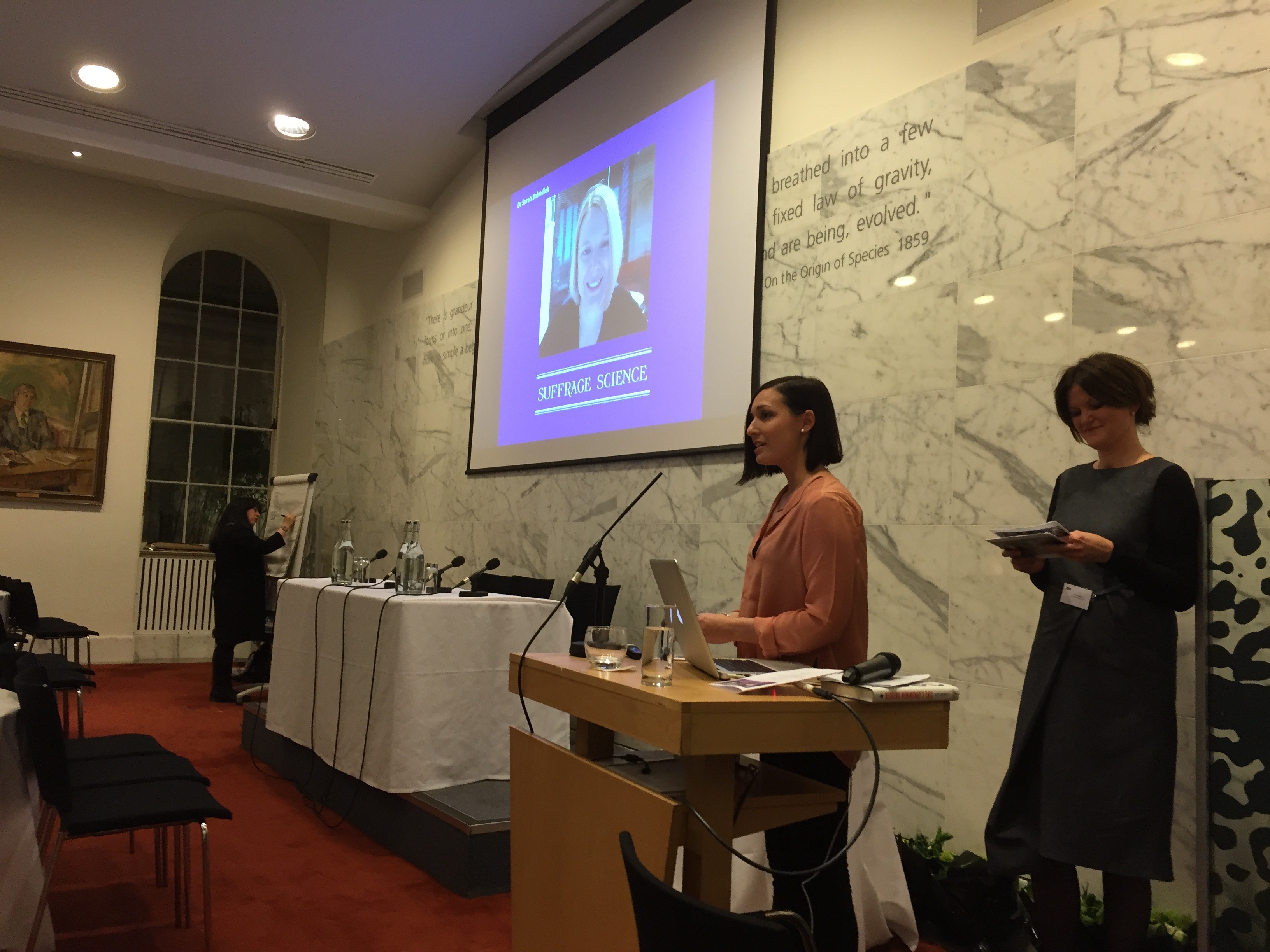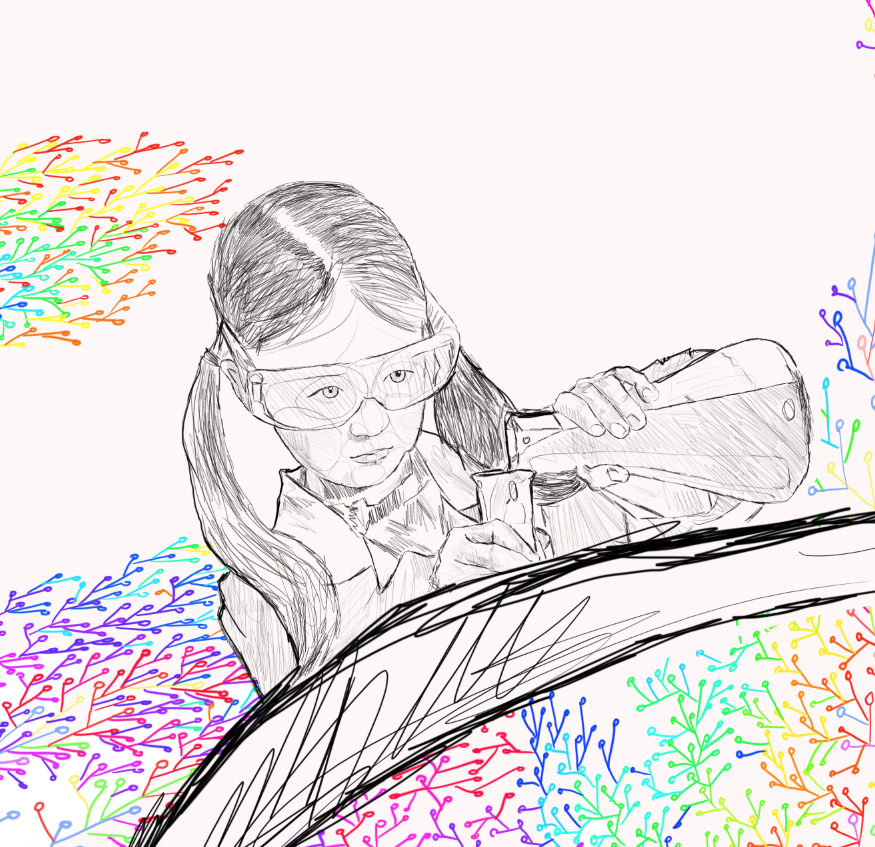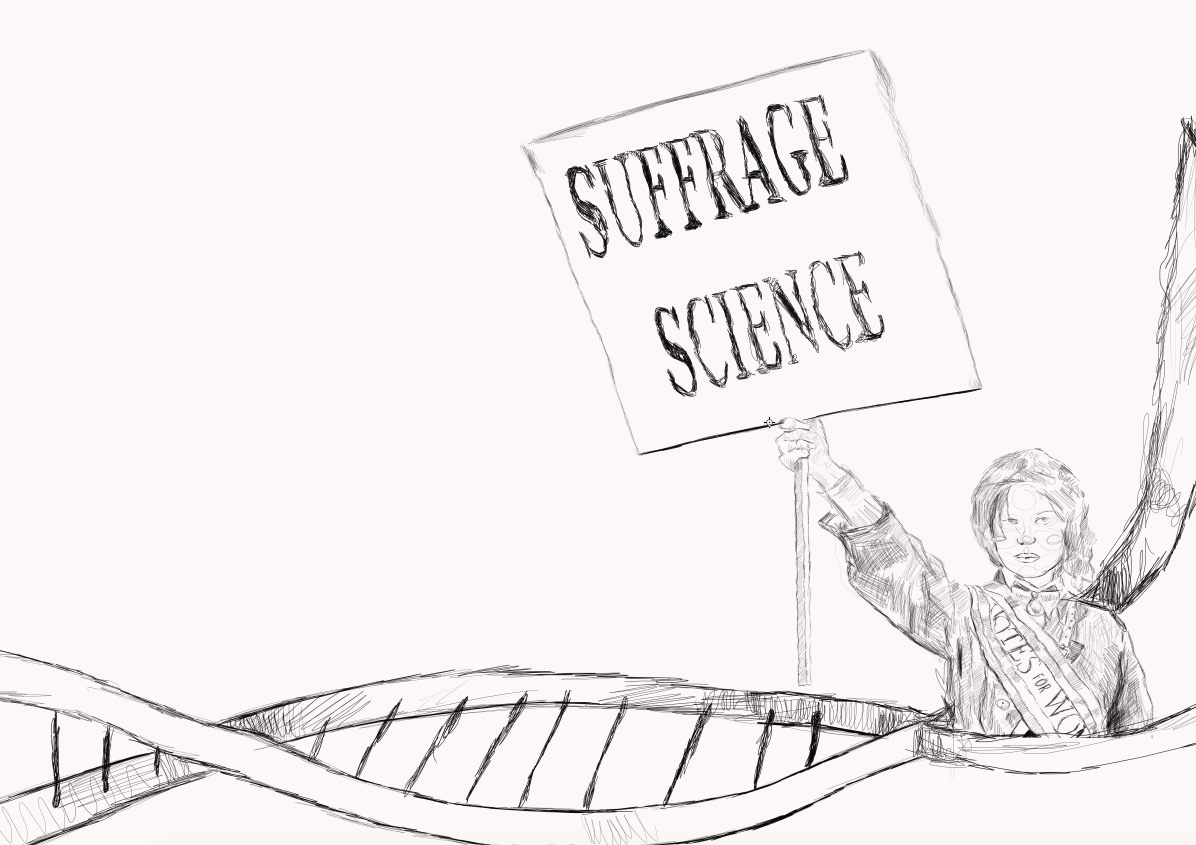By Helen Figueira
March 18, 2016
Time to read: 16 minutes

By Susan Watts
It was one of the most striking moments of the evening, and it came in the acceptance speech of Dr Sally John, a Suffrage Science awardee and vice president of computational biology and genomics at biotech company Biogen.
Dr John told guests how colleagues reacted when she told them she was leaving academia for industry. “Many people said they were sad to see me go because I’d been a great champion for women. One or two people even went so far as to say that I had a reputation for promoting and hiring women. I looked back over my eight years in that job, and it was exactly 50:50, there was no bias to women. That’s something that I found concerning, that that’s seen as active promotion when it’s only what we might expect in terms of our abilities and our potential.”
Her speech came as a new group of women in science joined the generations of awardees recognised under the Suffrage Science scheme, established by the MRC Clinical Sciences Centre (CSC) five years ago.
In a unique ceremony at the Royal Society on International Women’s Day (8th March), ten female scientists and one science communicator were handed their awards by existing award holders to recognise their scientific achievements and ability to inspire others.

This year’s awardees hail from industry and academia, from overseas as well as the UK, and from subjects as diverse as epigenetics to early brain development to personalised medicine.
The evening explored two themes. First, the nature of inspiration in science. Discussion examined where scientific inspiration happens and how, and explored whether being inspired by something or someone outside of the daily process of science at the lab bench can feed into and improve scientific endeavor itself.
This led to debate about how best to find the space for creative thought, and whether women find this harder to carve out, and why that might be.
Guests talked of drawing inspiration in their scientific work from multiple sources, including tea breaks that allow a chance for casual conversation, to the space and time for creative thought away from the lab, to the thrill of an actual scientific discovery in itself.
The second theme for the evening was a challenge, to all the women involved. They were asked what they will do to make a difference for women in science over the two-year cycle of the Suffrage awards.
Dr John made a concrete pledge:
“to use the Suffrage Science award to start an initiative in Biogen to provide more mentorship for women, and address issues of unconscious bias that are an undercurrent, and one of the reasons why women are not getting through the layers of management in academia and in industry.”
Others pledged to be more active in “sponsorship” of young women scientists, not just mentorship; to show young scientists that it’s acceptable to take time for family life and life beyond science because this can feed creative thought in science too; and to encourage young women to decide on a path, and to break scientific dogma.
The discussion was kept lively with the help of a three-strong panel: current award holders Professor Irene Tracey, who uses neuroimaging to understand pain, Dr Jenny Rohn who works on infectious diseases at UCL and is also a writer, and Dr Helen Pankhurst, activist and advocate for women’s rights and great granddaughter of Suffragette Emmeline Pankhurst. The host for the evening was writer and broadcaster Dr Kat Arney, a former postdoc at the CSC.
In seeking inspiration, some guests spoke about how they manage to create the time and space to think, and what they do to help junior scientists coming up behind them to do the same. Dr Rohn encourages her people not to work at weekends, and is strict about leaving on time every day to meet family commitments. “It’s important we don’t perpetuate this myth that to be a good scientist you have to be at the bench all the time,” she said.
“Having these pockets of space and time will lead to better science,” Professor Tracey agreed. “Having space for your personal life and other things that you enjoy doing, for your hobbies is ok. You can do that and be fulfilled and still be a good scientist. I think we just often bury these things and hide them because we’re under a bit of peer pressure that we’ve got to be seen to be clocking in at 7am and clocking out at 10am. I think we should celebrate the fact that actually you don’t need to.”

One of this year’s awardees, Professor Corinne Houart of King’s College London, made a case for a greater focus on what scientists do, rather than how long they spend doing it. “There’s a huge increase in quality if you stop and take the time to think deeper and do just the meaningful experiment.”
Professor Elizabeth Simpson, a former deputy director of the CSC, spoke about the importance to her of her writing, and said she’d been impressed by the value of interests outside of science early in her career when she worked alongside Peter Medawar. He actively encouraged his teams to enjoy the arts and music: “too many young scientists these days don’t think laterally,” she said.
For Dr Mariann Bienz of the MRC’s Laboratory of Molecular Biology, it’s the science itself in which she finds inspiration. “This rare beast called scientific discovery. Sometimes it’s a small thing, sometimes it’s really big. And that excites me and really inspires me to think and to get my head around it. What does it mean and so on. And I really hope that there are many women here who are equally inspired just simply by the scientific discovery.”
“You have to value your male allies”
The CSC was represented by Dr Petra Hajkova, who leads the institute’s Reprogramming and Chromatin group. She talked of broader attitudes in society and about her shock at the results of a 5000-strong pan-European survey, late last year, which asked about people’s perceptions of scientists. This found that some 67% didn’t believe women have the skills to be senior scientists. When asked for which fields women do possess the right aptitude, 89% of respondents said “anything but science”, pointing to the social sciences, communication and languages as being suitable.
The evening drew to a close with more contributions on broader issues of gender equality, and whether problems that keep women out of science and from progressing reflect these larger societal concerns. Eva Kyriacou, Corinne Houart’s daughter and A Level student spoke up for the need to include men in the push for change. “In the same way that the LBGT plus community really value their straight allies, the people that support them, it’s important for the feminist movement to understand that you have to value your male allies.”
Dr Pankhurst said she’s all for including men, and sees this as pivotal. They have an important role to play, she said, in calling out sexism whenever they encounter it. She asked female scientists in the room to add their voices to broader activist voices in society campaigning for change, such as the aid organisation Care International which supports access to education for girls and women across the world, and for which she is the UK ambassador.
Professor Simpson ended with what she thought might be a controversial point, that women can sometimes be their own worst enemies. “Women feel constrained by societal expectations as to what they should have ambitions to do. Very few people will stand in your way if you really decide what you want to do. You will find friends of both sexes, colleagues, partners and spouses will support you. But there’s a certain fearfulness about actually coming to the decision that that’s the path you’re going to follow. Young women need encouragement to take that path.”
Sponsors
L’Oreal-UNESCO For Women in Science scheme
The Royal Society
Contact
Susan Watts
Head of Communications and Public Engagement
MRC Clinical Sciences Centre
L: 0208 383 8247
M: 07590 250652
E:
The discussion was kept lively with the help of a three-strong panel: current award holders Professor Irene Tracey, who uses neuroimaging to understand pain, and Dr Jenny Rohn who works on infectious diseases at UCL and is also a writer and Dr Helen Pankhurst, activist and advocate for women’s rights and great granddaughter of Suffragette Emmeline Pankhurst. The host for the evening was writer and broadcaster Dr Kat Arney, a former postdoc at the CSC.
In seeking inspiration, some guests spoke about how they manage to create the time and space to think, and what they do to help junior scientists coming up behind them to do the same. Dr Rohn said she encourages her people not to work at weekends, and is strict about leaving on time every day to meet family commitments. “It’s important we don’t perpetuate this myth that to be a good scientist you have to be at the bench all the time,” she said.
“There’s a huge increase in quality if you stop and take the time to think deeper”
“Having these pockets of space and time will lead to better science,” Professor Tracey agreed. “Having space for your personal life and other things that you enjoy doing, for your hobbies is ok. You can do that and be fulfilled and still be a good scientist. I think we just often bury these things and hide them because we’re under a bit of peer pressure that we’ve got to be seen to be clocking in at 7am and clocking out at 10am. I think we should celebrate the fact that actually you don’t need to.”

One of this year’s awardees, Professor Corinne Houart of King’s College London, made a case for a greater focus on what scientists do, rather than how long they spend doing it. “There’s a huge increase in quality if you stop and take the time to think deeper and do just the meaningful experiment.”
Professor Elizabeth Simpson, a former deputy director of the CSC, spoke about the importance to her of her writing, and said she’d been impressed by the value of interests outside of science early in her career when she worked alongside Peter Medawar. He actively encouraged his teams to enjoy the arts and music: “too many young scientists these days don’t think laterally,” she said.
For Dr Mariann Bienz of the MRC’s Laboratory of Molecular Biology, it’s the science itself in which she finds inspiration. “This rare beast called scientific discovery. Sometimes it’s a small thing, sometimes it’s really big. And that excites me and really inspires me to think and to get my head around it. What does it mean and so on. And I really hope that there are many women here who are equally inspired just simply by the scientific discovery.”
“It’s important we don’t perpetuate this myth that to be a good scientist you have to be at the bench all the time”
The CSC was represented by Dr Petra Hajkova, who leads the institute’s Reprogramming and Chromatin group. She talked of broader attitudes in society and about her shock at the results of a 5000-strong pan-European survey late last year which asked about people’s perceptions of scientists. This found that some 67% didn’t believe that women have the skills to be senior scientists. When asked for which fields women do possess the right aptitude, 89% said “anything but science”, pointing to the social sciences, communication and languages as being suitable.

The evening drew to a close with more contributions on broader issues of gender equality, and whether problems that keep women out of science, and from progressing, reflect these larger societal concerns. Eva Kyriacou, Corinne Houart’s daughter and an A Level student, spoke up for the need to include men in the push for change. “In the same way that the LBGT plus community really value their straight allies, the people that support them, it’s important for the feminist movement to understand that you have to value your male allies.”
Dr Pankhurst said she’s all for including men, and sees this as pivotal. They have an important role to play, she said, in calling out sexism whenever they encounter it. She asked female scientists in the room to add their voices to broader activist voices in society campaigning for change, such as the aid organisation Care International which supports access to education for girls and women across the world, and for which she is the UK ambassador.
Professor Simpson ended with what she thought might be a controversial point, that women are sometimes their own worst enemies. “Women feel constrained by societal expectations as to what they should have ambitions to do. Very few people will stand in your way if you really decide what you want to do. You will find friends of both sexes, colleagues, partners and spouses will support you. But there’s a certain fearfulness about actually coming to the decision that that’s the path you’re going to follow. Young women need encouragement to take that path.”

Check back later to listen to the audio recording of the event, and to see progress on Marta’s artwork.
Sponsors
L’Oreal-UNESCO For Women in Science scheme
The Royal Society
Awardees received an “heirloom” item of jewellery created by students of the art and design college Central St Martins-UAL, drawing inspiration from scientific research and from jewellery worn by the Suffragettes, from which the award scheme takes its name.
Established in 2011 and nurtured by institute director Professor Amanda Fisher, Suffrage Science celebrates women already in science and encourages others to stay. As the jewellery is passed on, this creates a connected group of women that reaches across multiple generations of scientists. The scheme includes a life sciences and a physical sciences cohort, with plans to expand.
Highlights from this year’s winners
Full speeches here
“Science is a great career and one of the best things is discovering something new. I think the best thing we can do is have fun in science and surround ourselves by other people having fun.”
Dr Lori Passmore, MRC-LMB, Cambridge
“I think it’s really important to show the next generation that science is tough. It’s hard, it’s not easy. It takes a lot of our effort and our emotion and our strength. But it’s not just that it’s hard. We can do this together. I think it’s important for us to take them under our wing and to show them that you can be a strong woman in science. You can be a passionate leader. And you can also be kind and respectful to your students and to really make time for them.”
Dr Michelle James, Stanford University, California
“If we can bring a little of ourselves to this jewellery and pass it on as part of the heirloom, I’d like to bring a little bit of the pioneering spirit of the women of South Australia, imbue that on that, and these women managed to get what they wanted simply by asking with no other fuss involved so perhaps that’s something we could draw inspiration from.”
Dr Airlie McCoy, University of Cambridge
“I’m going to speak up a bit more often and not let the jokes pass and seek out opportunities to strengthen women in science and strengthen their careers.”
Professor Catherina Becker, University of Edinburgh
“Girls are not afraid actually of joining labs that are not well known. They are joining the science and the person who’s running the lab. Where maybe boys are more impressed by the shiny science and the shinier labs.”
Dr Déborah Bourc’his, Institut Curie, Paris
“I think this is something really special that we dare to personally tell each other that we’re doing something good. And I think we should do that every day. And not only at the awards ceremony.”
Professor Marja Jäätela, Danish Cancer Society Research Centre
“I see fiction as a great way of reaching out to new audiences and really telling them the hidden stories of science and scientists, sometimes female scientists. A lot of my work is around women working in science, sometimes inspired by real women scientists.”
Dr Pippa Goldschmidt, University of Edinburgh
“What I like really about this, and about what’s happening today, is that we celebrate connections not so much individuals and I think that’s a very female thing to do – is to really recognise the value of the group and the interaction and the mixing together instead of the individual and the ego. And I want to see much more of that in leadership, in science, all aspect of our lives.”
Professor Corinne Houart, King’s College London
“I think the network aspect of this award is amazing, it’s really great, and that’s what I study in my own field and I know it’s the networks and the links that are important rather than just any particular unit.”
Professor Kia Nobre, University of Oxford
“One of the elements that I take from the Suffrage Science program is that it is important that we learn about our history as women in science, and that we share this history with others to encourage them along their paths to success.”
Dr Uraina Clark, Icahn School of Medicine at Mount Sinai, New York
“We’re going to use this award to start an initiative in Biogen to provide more mentorship for women and also address some of these issues around unconscious bias that are an undercurrent, and one of the reasons why women are not getting through the layers of management in both academia and in industry.”
Dr Sally John, Biogen, Boston